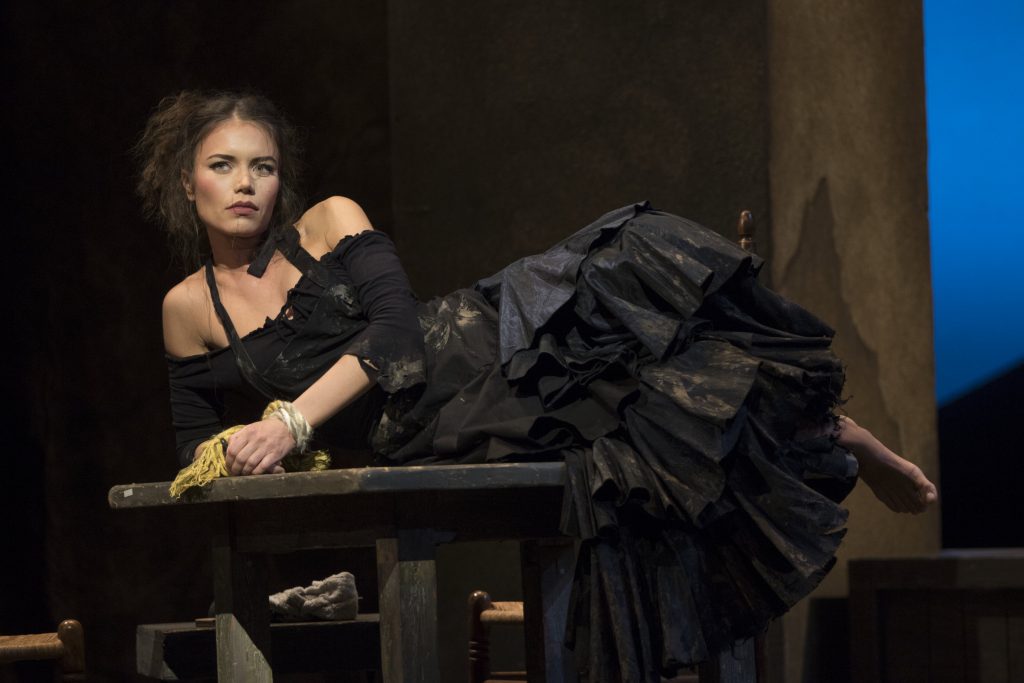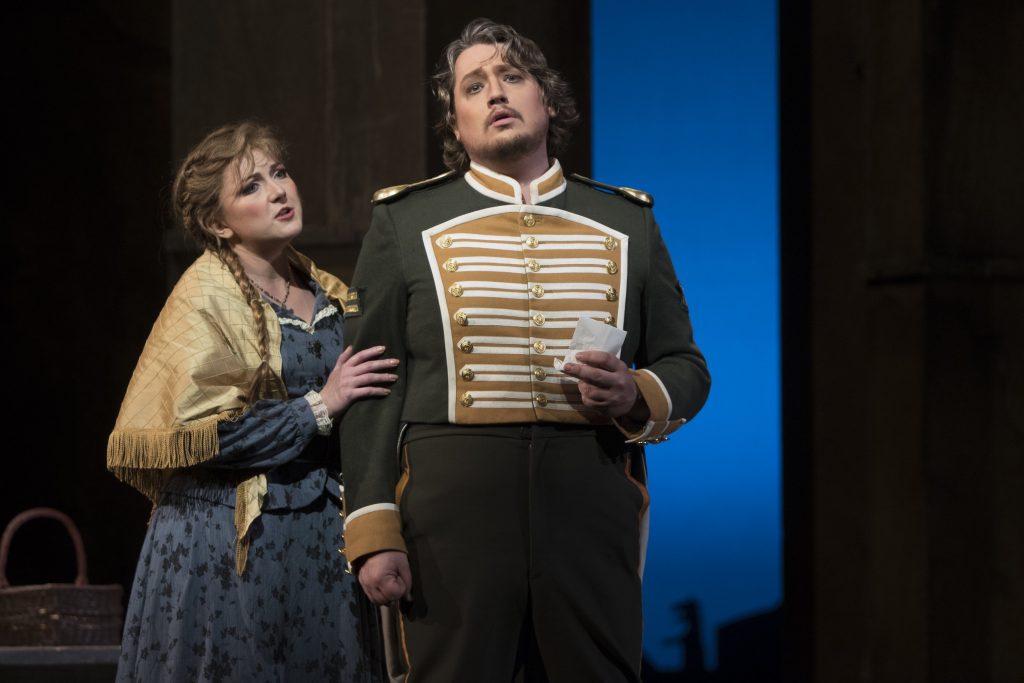Ginger Costa-Jackson’s Nonpareil Carmen Scores for San Diego Opera
No impresario has to apologize for scheduling yet another Carmen production. One of the most popular and perhaps the most recognizable property in the operatic canon, Carmen needs no hype to get the public in the door.

Ginger Costa-Jackson [photo (c.) J. Kat Woronowicz]
Vocally and dramatically, Costa-Jackson’s Carmen is simply nonpareil. At Carmen’s opening night performance on Saturday, March 30, the first act plodded along dutifully—almost listlessly—until she appeared. Corporal Morales, the incisive, bright-voiced baritone Brian Vu, and the other soldiers nattered aimlessly and teased Sarah Tucker’s Micaëla, whose splendid soprano fully revealed itself later in the act. The women of the San Diego Opera chorus made the workers on break from the cigarette factory sound so mellifluous, they could have been on break from the Seville cathedral choir.
But once Costa-Jackson started her gently entrancing “Habanera,” the whole production shifted into high gear, a passionate trajectory that climaxed at the conclusion of her triumphant “Seguidilla” at the close of the act. Costa-Jackson’s mezzo-soprano displayed the qualities a great Carmen requires: a slightly dark, almost glowering lower range that blooms vibrantly mid-range and then focuses with bell-like clarity in her highest range. Of equal importance, Costa-Jackson flirted without vamping and communicated Carmen’s inner strength without overriding her character’s outcast status in the social order.
Her Carmen evolved confidently as she lured Don José, tenor Robert Watson, from his military duties into her gypsy band, and she flourished in the company of her buoyant comrades Frasquita, soprano Tasha Koontz, and Mercédès, mezzo-soprano Guadalupe Paz. After their frothy but beautifully sung Act III fortune-telling duet over playing cards, Costa-Jackson’s bone-chilling terror from reading her deadly fortune from her own cards quickly turned her course to a stark but bold acceptance of her fate.
Watson’s confident, ample tenor imbued his Act II “Flower Song,” “La fleur que tu m’avais jetée,” with ardor, and he rose valiantly to his confrontation with Carmen in the final act. Although he worked hard portraying a convincing Don José, Costa-Jackson simply was Carmen.

Sarah Tucker & Robert Watson [photo (c.) J. Kat Woronowicz]
Scott Conner’s Escamillo, the dashing toreador who steals Carmen’s affections and enrages Don Jose, brought his rich bass to the famous “Toreador Song,” conveying his commanding, virile persona. If only his gait and his mannerisms appeared equally macho.
San Diego Opera’s cast of strong, well-trained voices also featured the hearty bass-baritone Patrick Blackwell as Lieutenant Zuniga; baritone Bernardo Bermunez as Dancairo and tenor Felipe Prado Remendado, two of the gypsy leaders who carry out much of the stage action in the opera’s middle acts.
Whether soldiers, factory workers, or denizens of the gypsy camp, Chorus Master Bruce Stasyna’s choristers sang with unusual allure and poise. The chorus of children plays a key role in two crowd scenes; Martin Green trained these 14 young singers with equal emphasis on solid ensemble and an edgy sound that was appropriate for street urchins.
Under the assured baton of Conductor Yves Abel, the San Diego Symphony gave a bracing account of Bizet’s rich and familiar score. Principal Flute Rose Lombardo and Principal Harp Julie Smith Phillips could not have been more persuasive and luminous in the exquisite Act III entr’acte.
Following Kyle Lang’s choreography in the opera’s prelude and entr’actes, Principal Dancers Laurence Gonzalez and Lester Gonzalez gave arresting, abstract interpretations of the conflicting emotional states depicted in Bizet’s score.
The pace of the first act’s opening and that of the denouement of Act IV needs to be tightened, but otherwise, Kyle Lang’s stage direction served the course of the opera well. The set, designed by R. Keith Brumley and constructed by Lyric Opera of Kansas City, tended to keep the action towards the front of the stage, which limited the movement on stage in an opera that is replete with ensemble activity. Of the numerous Carmen sets I have seen, this proved to be an unusually dull unit set, both in its drab colors and a stubbornly plain design. The exterior of the bullring was so drab, it was hard to imagine it as a building in cosmopolitan Seville. It gave the impression of a run-down ring in a small town in the hinterlands. Fortunately, the bright and varied hues of James Schuette’s period costumes compensated.
San Diego Opera presented this production of Bizet’s “Carmen” on March 30, 2019, in San Diego’s Civic Theatre. It will be repeated in the same venue on April 2, 5 & 7, 2019.

Ken Herman, a classically trained pianist and organist, has covered music for the San Diego Union, the Los Angeles Times’ San Diego Edition, and for sandiego.com. He has won numerous awards, including first place for Live Performance and Opera Reviews in the 2017, the 2018, and the 2019 Excellence in Journalism Awards competition held by the San Diego Press Club. A Chicago native, he came to San Diego to pursue a graduate degree and stayed.Read more…



Sarah Tucker had a horrible, wide, flapping vibrato. I was disgusted by what I heard. I couldn’t believe she got applause from the clueless, super provincial San Diego Opera audience. She is a fraud. Her YouTube videos feature a lovely voice. Live, her timbre was meh and the uncontrolled vibrato was seriously off putting. The other three principal singers, Ginger Costa-Jackson, Robert Watson, and Scott Conner, all sang with rock steady tone.